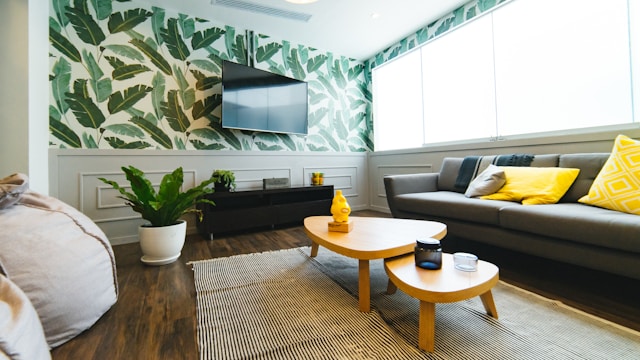Looking for an easy way to give your space a fresh, stylish update without committing to paint or hiring a contractor? Peel-and-stick wallpaper is one of the most versatile and renter-friendly options on the market. Whether you’re sprucing up a bedroom, creating an accent wall, or transforming your bathroom, this DIY wallpaper solution can completely change the look and feel of a room in just a few hours.
In this guide, you’ll learn how to install peel-and-stick wallpaper like a pro, from wall prep to perfect application, along with expert tips for avoiding bubbles, misalignment, and other common pitfalls.
Why Choose Peel-and-Stick Wallpaper?
Peel-and-stick wallpaper (also known as removable wallpaper) has become increasingly popular among both homeowners and renters. Unlike traditional wallpaper that requires paste or water, peel-and-stick designs come with an adhesive backing, making them simple to apply and remove.
Benefits of peel-and-stick wallpaper:
-
No mess, paste, or glue required
-
Easy to reposition or remove without damaging walls
-
Great for renters and DIYers
-
Huge variety of patterns, textures, and colors
-
Budget-friendly makeover solution
Whether you’re updating a single wall or covering an entire room, learning how to install peel-and-stick wallpaper is a worthwhile skill that can elevate your home décor.
Tools and Materials You’ll Need
Before you get started, make sure you have the right tools on hand. A successful wallpaper installation depends on careful preparation and the proper supplies.
Materials checklist:
-
Peel-and-stick wallpaper rolls
-
Measuring tape
-
Level or plumb line
-
Pencil
-
Utility knife or sharp scissors
-
Smoothing tool (plastic squeegee or credit card)
-
Step ladder
-
Clean microfiber cloth or sponge
Having all your tools ready will help you stay organized and focused as you apply your removable wallpaper.
Step 1: Prep the Wall
Preparation is key to a clean, smooth finish. Peel-and-stick wallpaper adheres best to clean, flat, and dry surfaces.
How to prep the wall:
-
Wipe down the wall with a damp cloth to remove dust and dirt.
-
Fill any holes or cracks and sand them smooth.
-
Let the wall dry completely before applying wallpaper.
-
If the wall is newly painted, wait at least 4 weeks for the paint to cure.
-
Avoid textured surfaces unless the wallpaper is designed for them.
If you’re working on a glossy or slick wall, consider applying a coat of primer or flat paint to improve adhesion.
Step 2: Measure and Plan Your Layout
Knowing how to install peel-and-stick wallpaper correctly starts with proper measurement and planning. Measure the height and width of your wall and calculate how many wallpaper rolls you’ll need, factoring in pattern repeats and a few extra inches for trimming.
Tips for layout planning:
-
Use a level or plumb line to draw a straight vertical guideline where your first panel will go.
-
Start in the least noticeable corner or edge (unless you’re centering a pattern on a feature wall).
-
Always match the pattern at the seams to maintain a seamless look.
Good planning makes the application process smoother and reduces the chances of wasting wallpaper.
Step 3: Apply the Wallpaper
Now for the fun part installing the wallpaper! Here’s a step-by-step breakdown for a professional-looking finish.
Step-by-step wallpaper installation guide:
-
Peel about 10–12 inches of the backing paper from the top of your wallpaper panel.
-
Align the top edge with your guideline and gently press it to the wall.
-
Use a smoothing tool to eliminate bubbles and ensure firm adhesion.
-
Slowly peel the backing downward while pressing and smoothing the wallpaper as you go.
-
Work in small sections to maintain control.
-
Match the pattern on the next panel and repeat the process, slightly overlapping the edge if recommended by the manufacturer.
-
Use a utility knife to carefully trim excess wallpaper around edges, outlets, and corners.
Take your time rushing can lead to air pockets, misalignment, or stretching the material.
Common Mistakes to Avoid
Even experienced DIYers can run into trouble when applying wallpaper. Here are some mistakes to avoid:
-
Skipping wall prep: Dust, grime, or uneven surfaces can ruin adhesion.
-
Not using a level: Crooked lines can throw off your entire project.
-
Overstretching the material: Peel-and-stick wallpaper can warp if pulled too hard.
-
Misaligning patterns: Always double-check alignment before smoothing.
If you do make a mistake, gently peel the wallpaper back and reposition it most high-quality peel-and-stick wallpapers are repositionable.
Pro Tips for a Flawless Finish
Want to achieve that crisp, clean look? Follow these pro tips:
-
Work slowly and deliberately.
-
Smooth outward from the center to the edges to avoid trapping air.
-
Trim excess material with a sharp blade for clean edges.
-
Keep your hands and tools clean to avoid smudging the wallpaper.
-
Use natural light or a bright work lamp to catch imperfections.
If bubbles appear after application, use a pin to gently release trapped air and smooth it down.
Maintenance and Removal
One of the best features of peel-and-stick wallpaper is that it’s just as easy to remove as it is to install.
How to care for removable wallpaper:
-
Wipe with a damp cloth to clean avoid abrasive cleaners.
-
Avoid excessive moisture or steam (not ideal for bathrooms without ventilation).
-
To remove, peel from a corner and slowly pull downward at a 45-degree angle.
Most peel-and-stick wallpaper won’t leave residue, but test a small area if you’re concerned about wall damage.
Final Thoughts
Knowing how to install peel-and-stick wallpaper like a pro can help you upgrade your home with style, ease, and confidence. Whether you’re working on an accent wall, a rental-friendly makeover, or a full room transformation, this DIY wallpaper project offers maximum impact with minimal effort.









